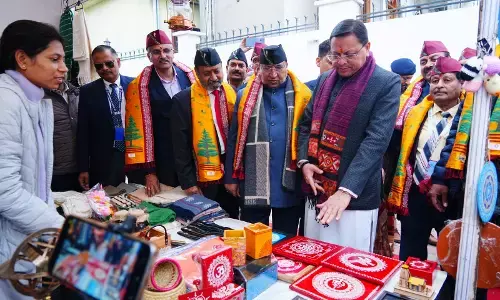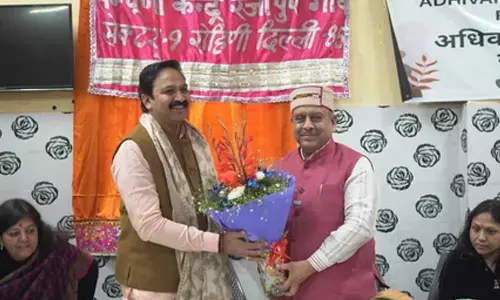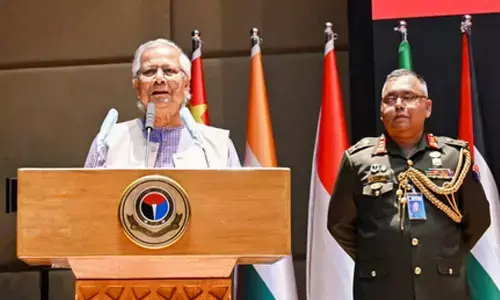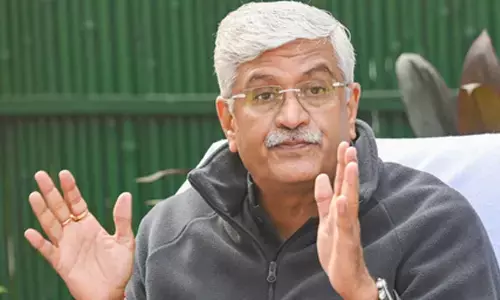Wages of poor strategy

Ramachandra Murthy: Wages of Poor Strategy. Is Chief Minister Kiran Kumar Reddy a pretender or a crusader? Common sense and a risk-taking nature are two most important characteristics that are needed in a politician to be successful. Kiran Reddy has proved to be a resourceful pugilist in the political ring.
The chief minister could have visited the families of the agitators who died in police firing at Sompet in Srikakulam district fighting against the proposed thermal plant in their fields that yield three crops a year. It was the only way to prove that he had a sense of justice.
Is Kiran Reddy really interested in the unity of Telugus? Is he really prepared to do anything to keep the State united? Or is it only a continuation of an elaborate drama the script of which was written by someone in the party high command?
.jpg) Is Chief Minister Kiran Kumar Reddy a pretender or a crusader? Common sense and a risk-taking nature are two most important characteristics that are needed in a politician to be successful. Kiran Reddy has proved to be a resourceful pugilist in the political ring. He has been fighting with his back to the wall, surprising everyone with his dogged opposition to bifurcation of AP. Those who thought that the chief minister would give in after resisting for some time are forced to revise their opinion.
Is Chief Minister Kiran Kumar Reddy a pretender or a crusader? Common sense and a risk-taking nature are two most important characteristics that are needed in a politician to be successful. Kiran Reddy has proved to be a resourceful pugilist in the political ring. He has been fighting with his back to the wall, surprising everyone with his dogged opposition to bifurcation of AP. Those who thought that the chief minister would give in after resisting for some time are forced to revise their opinion.
Is Kiran Reddy really interested in the unity of Telugus? Is he really prepared to do anything to keep the State united? Or is it only a continuation of an elaborate drama the script of which was written by someone in the party high command?
Had he been a diehard integrationist, as he loudly professes almost on a daily basis, he would have behaved in an entirely different way. He would have taken measures to dispel doubts in the minds of Telangana people and to inspire emotional integration.
There was absolutely no indication until a few days before July 30, the day the Congress Working Committee passed the Telangana resolution, that Kiran Reddy felt so strongly about the unity of Telugus. In a way, Kiran Reddy missed a golden opportunity. He succeeded Konijeti Rosaiah, a tired old horse who was always sitting tentatively on the edge of chief minister’s chair. By that time Chidambaram, as Union Home Minister, had made the historic announcement that the process of creating Telangana State would soon be initiated.
Seemandhra politicians belonging to the Congress and the TDP had revolted and the Centre had to put the decision on the hold. Kiran had three full years to convince his party high command, then the political class in the State and ultimately the people on the desirability of living together in one State. It would have been a great reversal.
Had Kiran taken up the task of reconciliation in right earnest, he would have succeeded where every chief minister from Neelam Sanjiva Reddy to Rosaiah had failed. None of the former chief ministers had consciously and deliberately acted to bring about emotional unity among the people of all regions in the State.
The chief minister noted in his 86-page memorandum submitted to the Group of Ministers (GoM) on the 18th that the “Gentlemen’s Agreement” was not properly implemented. He could have tried to make amends for the historical mistakes and brought the people of the State around to believe that it is, after all, possible to coexist in one State in a manner that would help the Telugu-speaking people develop in a happy and congenial atmosphere instilling mutual confidence.
If persuaded, the people would agree to give one more try. As a starter, he would have requested the party high command to appoint one person from Telangana in at least one of the four important political positions: chief minister, PCC president, Council chairman and Assembly Speaker. A high-powered committee to oversee the release of Krishna water from Srisailam and Nagarjuna Sagar would have gone a long way.
In other words, he should have found answers to all the questions raised by the leaders of Telangana movement and implemented them. He would have visited the families of the farmers in Adilabad, Medak, Warangal and Anantapur districts who had committed suicide even after he took over the reins. In his regime, the activists working in this area say the revenue and police officials were refusing to register suicide cases.
They were reported to have told the activists that they had unwritten orders from the State government not to record suicides by farmers. The chief minister could have visited the families of the agitators who died in police firing at Sompet in Srikakulam district fighting against the proposed thermal plant in their fields that yield three crops a year. It was the only way to prove that he had a sense of justice.
If Kiran really loved all the Telugus, he would have loved the youth of Telangana too. He would have consoled the families of the youngsters who killed themselves in a fit of emotion. He could have motivated the Congress leaders from Telangana to work for the unity of Telugus by weaning the people away from the separatist sentiment. He would have created a mechanism comprising highly committed persons with a sense of justice to monitor the implementation of the promises made and agreements signed. He would have persuaded his ministers and other Congress leaders from Telangana to participate in the World Telugu Conference organized at Tirupati after a lapse of many years.
Even after he had decided to rebel against the Congress high command in the wake of its decision to bifurcate AP, he could have spoken as a chief minister genuinely interested in the welfare of the Telugus in both the regions. Instead, he comes across as a partisan politician who has been trying to create a constituency for himself in Seemandhra. If Kiran is really keen on preventing bifurcation, he would have made the PowerPoint presentation two years ago instead of doing it just before the CWC resolution.
He would not have repeatedly told Sonia Gandhi that her decision on the Telangana tangle would be final and binding on all the Congressmen in the State. One could assume that Kiran’s belligerent stand against bifurcation is the result of a careful calculation, the limited options before the Congress leadership and the UPA government and the growing gulf between the people of Seemandhra and Telangana. He might have seen a window of opportunity for him in the present crisis.
The Constitution envisaged a pivotal role for a chief minister. He is central to all the decisions in his State. Even in the midst of unprecedented political uncertainty, Kiran Reddy could push a Rs 6000-crore project intended to take drinking water from Kandaleru reservoir dead storage in Nellore district to his native Chittoor district. Such are the powers a CM is bestowed with.
Kiran Reddy knows that the UPA government cannot afford to dismiss him in spite of his provocations. He appears to have made up his mind to make use of his position as a chief minister to get maximum mileage before bowing out at an opportune time.
The reported clash with Speaker Nadendla Manohar on proroguing the Assembly could be the latest act in one-upmanship and brinkmanship. While showing Manohar in a poor light to the people of Seemandhra by painting him as a politician who is helping the Centre in bifurcating the State, Kiran Reddy can hope to further mobilize public opinion in his favour. What he would do with the support base he has been trying to create for himself is a moot point.
He would have relevance only if the State is united when the next elections are underway. He can rightly claim to have prevented bifurcation. If the State is divided before the hustings, he would have absolutely no role. He would be treated as a former chief minister who failed in his attempt to preserve the unity of the State. Considering all the factors, Kiran Reddy must have decided to go down fighting instead of tamely following the official line. Let us give him the benefit of the doubt.

















